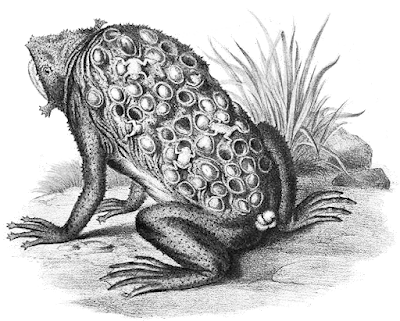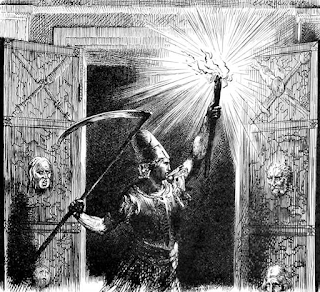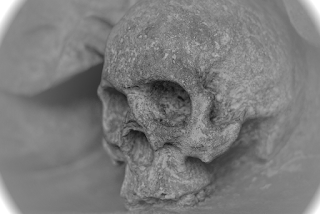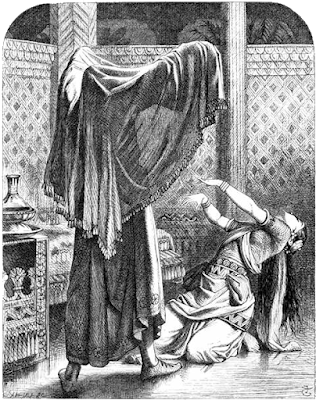
|
Scale: 10 ft.
Click here for a PDF version of this
adventure!
|
Trying out a new keying for locks, stuck, and secret doors.
| • |

|
A little keyhole icon means the door is locked. |
| • |

|
A little "S" through the door means the door is secret. |
| • |

|
The other icon - which is supposed to look like a muscly arm - indicates
the door is stuck and must be forced open.
|
Let me know what you think!
0 - Entry
0A - Silver Hall
A hall leads away from the entry stairs.
Along the walls are silver-lined torches, lit, along the walls: four on either
side.
They will continue to burn indefinitely unless removed from the wall - in
which case they will burn for 1 hour, same as any other torch. They are worth
30 gp each for their materials - regardless of whether they have been consumed
or not.
1 - North-West Chambers
1A - Shocking Hall
The walls of this hall are lined with reptilian iconography, carved into the
walls. In the center of the room is hidden a false floor which, if triggered,
will drop anyone on top of it 15 feet into an electrified pool of water. It is
not deep enough to drown, but any character in the water takes 1d6 points of
damage per round until they are rescued and must Save vs Paralysis (-2
penalty, if in metal armor) each round or be paralyzed for that round by the
spasm-inducing current.
1B - Ringed Pool
A narrow pool rings this space. It is around six inches across, three inches
deep, and is easily bypassed. The water inside is normal water, slowly flowing
in a clockwise direction.
1C - Baboon Menagerie
The doors into and out of this space are stuck. Behind a series of bars in the
center are 7 Rock Baboon (B41), seemingly trapped as though in a menagerie. On
the east side, in among the baboons but affixed to the wall, is a suit of
leather armor - magic, +1 - with an odd, sloping helmet. On the west wall,
equally affixed, a polearm of master quality: +1 to hit, but non-magical and
no bonus to damage.
1D - The Iron Box
Hanging from the ceiling - 20 feet above the heads of the characters - is a
metal chest, suspended from the ceiling by a chain.
Encircling the room is an invisible staircase, which will allow them to climb
indefinitely - the chamber having no physical ceiling: the chain being lashed
to some further surface, just out of reach of the torchlight. Inside the
locked chest is 600 silver pieces and 200 gold pieces.
1E - Frilled Mosaic
On the floor, a mosaic details the head of a lizard: complete with red frill.
It is a bit chipped, but otherwise in good order.
1F - Lizardman Bunkhouse
This room smells. Four Lizard Men (B38) have taken up residence in it:
littering the place with their nesting material. They are not aware of the
secret door.
1G - The Protoman's Office
In side this room is a writing desk - slightly wrong in proportion to a human.
Against the far wall is a chest - dramatically under-filled with 100 sp. In
the desk can be found a pouch with three Cat's Eyes (10 gp each) and three
Amethyst (100 gp each)
1H - Fresco Pool
The north and south walls of this space are lined with columns. There was once
a fresco between them - but it has since decayed to the point where it is
impossible to tell what was depicted, apart from a blue color. In the center
of the room is a pool. A five headed Hydra (X33) is sleeping in the water.
2 - North-East Chambers
2A - A Ghoul's Dining Hall
Near the center of the space, there is the skewered remains of several
adventurers. They have been skewered by a trap in the room - when triggered,
anyone within 10 feet of the doors to the south-west must Save vs Paralysis or
be crushed between two masher-like sections festooned by spikes that come
together, having sprung out from the flanking walls.
Four Ghouls (B35) are eating the remains of the adventurers remains. Two of
the ghouls wear expensive wedding bands - 700 gp each - one wears a gold chain
(1,000 gp), and one of the dead adventurers is clutching a bedecked holy
symbol - prominent emeralds - worth 1,300 gp. The Ghouls are aware of the trap
and may (2-in-6) attempt to use it to their advantage, if pressed.
2B - Hall to Nowhere
A carpet - moist, mildewing at the sides, runs the length of this room.
2C - Troglodyte Den
Three Troglodytes (B44) have taken up residence in this space. They are
resting, not having made it their home yet, but the room still reeks:
smellable from the hall beyond to an observant character.
2D - South Prison
This room consists of iron-barred alcoves: seemingly with no entrance. The one
to the south contains humanoid bones; the two to the north contain a single
Hobgoblin (B36), each, who - as the party approach, are playing a simple board
game akin to Backgammon: calling their moves to one another from across the
way.
2E - North Prison
Along this hall are several iron-barred alcoves. The bars have no doors or
other visible mechanisms of egress. In the easternmost are 2 Berserkers (B32)
- in the center, 3 more Berserkers. They woke up here recently and don't
recall how they got there.
2F - Spider Alcoves
The alcoves opposite to the double door contains a statue of a humanoid -
artfully carved - but missing several pieces to damage. To the north, the
alcoves are obscured by spider webs: excepting another statue, visible easily
in the north alcove: its eyes glitter in the torchlight: one is a harlequin
opal (100 gp value), the other, a matrix opal (50 gp value).
A single Black Widow (B42) spider lurks among the webs, hidden and
waiting.
2G - Flaring Gate, North Side
A brazier sits, unlit, ringed with pearl discs but filled with oil-smelling
charcoal, sits between two locked doors to the south.
A character interacting with the charcoal may trigger a pressure sensor on the
floor which will drop an ignition source into the charcoal: causing it to
flare up, destroying half the pearls and forcing any character interacting
with the brazier to Save vs Breath or take 1d8 fire damage. Characters thus
affected may have to Save for flammable gear carried above the waist.
The pearl discs are worth 110 gp.
2H - Flaring Gate, South Side
A brazier sits, empty, between two locked doors to the north.
The wall above it is blackened with ash.
2I - Revelatory Statue
A statue - artfully sculpted - stands in the alcove to the east, facing west.
If it is turned to face east, the secret door to the east will open.
2J - Waiting for the Ferryman
Two statues carved to seem haggard, wearing rags, flank a skeleton on a
raised, lidless coffin. The skeleton wears scale mail and is in a weird
position: as though tossing and turning in slumber. It never moves when under
observation, but will change position when observed at different times.
If 2 silver coins are placed on its eyes, it audibly sighs - as if in relief,
and shifts into a supine position. From that point, for the next 1d4 days, any
character in the room is invisible to any Undead. Note, not undetectable -
just invisible.
3 - South Chambers
3A - The Welcome Desk
To the east, a brown-black stain runs along the floor, close to the south
wall. To the west, an alcove with a desk in it: behind which sits a
long-rotted corpse in rusted scale armor. Five Robber Flies (B41) lurk in the
shadowed corners of the alcove. The corpse has a key to the door to the east -
if the party can get past the Robber Flies - but the key is rusted and old: it
will break off in the lock on a 2-in-6 chance.
3B - The Lectorium
Lecterns with stools line this room - smashed and tossed about, as though the
once orderly space was released into the care of apes. Among them, 7 Pit
Vipers (B42) have nested.
3C - North Storage
Several crates and chests are open in this room - they contain only cobwebs
and dust.
3D - South Lockers
Eight Lockers line the north wall - coat hooks, the east. One coat hangs - in
the pocket of which can be found 70 gp. If the lockers are opened, a cool
whistle will emerge from them, which echos in the space: for every other
locker opened, roll for a wandering monster: drawn by the noise.
4 - Secret Hall
4A - Treasure Trove
Beyond the secret door is a double pendulum trap: characters moving southwards
will - both at five feet and ten feet in - have a chance to trigger one of two
pressure plates, causing a bladed pendulum to swing down, alternating sides on
each swing, the trap having reset itself with the momentum of the first. Each
pendulum does 1+1d10 damage, striking with a THAC0 of 15 - however each can
only target one character per round: thus, if a group of 5 were to charge
through, at least 3 would make it through safely.
Beyond the traps is a hoard of treasure, piled among two skeletons (an Elf and
a Human) - with suspicious damage to their bones in keeping with a slashing,
crushing attack. The hoard contains the following:
- 12,000 sp
- 400 gp
- 1 jade trinket (10 gp value)
- 2 blood sapphires (100 gp each)
- 2 diamonds (500 gp each)
- 1 Potion of Giant Strength
5 - South-West Chambers
5A - Junction
The center of the junction in the hallway at this point is marked by a statue,
looking up. Above is a hole in the ceiling - 10 feet by 10 feet or so - that
is 40 feet deep. Interacting with the statue has a chance of triggering an
anti-gravity trap: wherein the statue will suddenly look down and any
character under the hole in the ceiling must Save vs Spells or fall upwards -
into the hole. At the "bottom" of this fall is a Gelatinous Cube (B35).
5B - Carpet Trap
A rich red carpet covers the bulk of the floor of this room. In each corner is
a statue - limbless, faces damaged and unrecognizable. If a character steps
onto the carpet, they may activate its trigger, wherein it rolls up -
capturing them inside. Save vs Paralysis to avoid, roll 2d6 once per turn to
escape (if unaided externally). Modifying the roll by Dexterity - representing
shimmying out, is a target number of 11; modifying the roll by Strength -
forcing the rug open - target number 9.
5C - Sculpted Entry
To the west, a series of finely sculpted statues adorn the squared alcove. To
the north is an iron gate, locked, but through the bars of which an observer
can see into 5D. A lonely Elf (B35) is contemplating the gate. He has the keys
to the doors between 2G and 2H - but he does not know that they key opens
those particular doors - and is wondering how (or whether) to approach this
locked gate, based on the beetles beyond.
5D - Oil Beetle Prison
Shackles line the walls of this space, affixed to the wall. A trough is cut
into the floor running through the center of the room. Six Oil Beetles (B31)
are tittering about the sluice.
6 - Northern Circle
6A - Glowing Crest
A drain rings the room - following its perimeter on all sides, six inches from
the wall. A large crest, the shape of a shield, is positioned on the south
wall - illuminated by a glow emanating from under the aforementioned drain. If
a character interposes themselves between the glow and the crest, the crest
opens outwards, dumping a wash of acid onto the floor. All characters in the
room must Save vs Breath: on a success, they suffer 1d4 points of damage from
fumes and the like; on failure, they suffer 1d6 points of damage each round
for 1d4 rounds as it washes over them.
The door to the west, locked, is iron. The door to the east is wood.
6B - Shield Room
On the west wall hangs a magic shield, +1. Beneath the shield is a square
lockbox containing 800 sp.
6C - Crystal Candle Room
Twelve iron rings hold twelve crystal votive candle holders, shaped like
flowers. The flowers, each, are worth 10 gp, but if candles are placed in them
and lit, the chance of finding the secret door increases by +1-in-6 for every
other candle lit: where it becomes evident that a section of wall is illusory.
6D - Old Vault
Several empty chests are strewn about this space. One remains closed, on its
side, locked and trapped with a poison needle in the mechanism. It contains
600 sp.
7 - Eastern Circle
7A - Consequences of Choice
All doors to this space are reinforced with iron and locked. If a character
opens either the north or west door, bars slide across the backs of the other
two doors to the space, preventing ingress or egress in those directions. The
open door is considered stuck: allowing ingress, of course, but will be
difficult to close.
7B - Pickled Thoul
Several barrels of pickled but still rotting ham are stored in the east
portion of the room. A single Thoul (B42) sits atop one - sharpening a cutlass
(treat as Sword). He arrived in a squire role to the Bugbear in room 7E: they
do not know he is undead - his motives for the deception are his own.
7C - Centerpiece Hall
A mosaic floor forms a concentric octagon - 8 feet off the chamber walls. The
mosaic depicts an ugly face: perhaps that of a corpse, or one distorted by
pain.
7D - Desert Locker
The door to this space is stuck - warm air seems to seep from the creases and
gaps in the door. If opened, a sudden gust will blow out, bringing with it
some sand. The room inside is empty - but articles left in the room will, over
the course of 24 hours, desiccate: leather is ruined, meat turns to jerky, and
so on.
7E - Bugbear Locker
Four Bugbear (B32) have barricaded this door shut. They are resting - eating
and playing a dice game - talking about the Thoul in 7B. They don't trust him,
though think him a standard Hobgoblin.
7F - Bucket of Shards
At first glance, the room appears to turn south rather than north from the
door. If a party continues southward, they will bump into a wall - triggering
a trough of crystal slivers to fall on the floor. Any characters in the front
rank must Save vs Breath or take 1d6 damage; any characters in the second rank
must Save vs Breath or take 1d3; and hence, movement through the space -
within 10 feet of the door, including into 7C, must be made cautiously. Moving
incautiously requires a Dex Check, failure of which causes the character to
slip and fall, taking 1d4 damage from the slivers.
The north wall is illusory. Behind it is a small horde of 1,100 silver and 600
gold pieces.
7G - Hidden Crushing Trap
In the center of this space is a pair of crushed skeletons, one wearing a
flattened suit of chainmail. One skeleton carries a set of keys - keys which
will open the door between 3A and 3B. By entering the room, however, the party
may trigger a trap: wherein the floor begins rising, taking 1+1d4 rounds to
reach the ceiling: crushing anything remaining inside the space.
7H - Shadow Locker
A lone Shadow (B41) haunts this space. Tucked into a missing stone in the west
wall, near the secret door to the south, is a strongbox containing 120 gold
pieces and three round-cut andalusite: each worth 100 gold pieces.
7I - Whistling Tunnel
A whistling sound can be heard and a slight breeze felt in this natural tunnel
- always coming from ahead of the party, no matter which way they go: dying
down and starting up again if they pause in the space. All doors out of this
space are obvious - no search is required - to find them from this side.
However, upon exiting this space - there is a 2-in-6 chance that the party
will exit from one of the three doors, randomly determined, instead of the
natural egress point.
A trail of 70 gold pieces leads from halfway up the north corridor towards the
east corridor.
7J - Old Foyer
Broken furniture has been piled in the north-west corner of this room. A
locked closet to the south-east contains a warm overcoat, slowly collecting
dust, and a pair of boots which is surprisingly clean. The boots are enchanted
- they will never tarnish and mud will slide off them with use - but they
convey no other special advantages.
8 - Western Circle
8A - Quarry Refuse
Crumbled marble - some appearing to have been a particular shape, but then
damaged or perhaps mis-cut - is piled up in this space.
8B - Adventurer's Hall
This room is illuminated on the east and west walls by runes written in the
Lawful script. To the west, "Adventure" - to the east, "Death".
8C - Rubble Room
The ceiling of this space is indented - roughly in the shape of the room, 5
feet from the walls. A pile of stone rubble and broken bricks sits in the
south-west corner.
8D - Planning Space
A decrepit table with a large chair at the head sits in this space. If the
party enters from 8C, there will be a ghostly figure in the room - stalking or
sitting, as deemed appropriate by the referee.
It will look at the party,
vaporize, and then will not be heard from or seen again.
8E - Hidden Egress
The doors out of this space are obvious - that is, no roll is required to
detect them from this side. If the party enters from 8D, a gentle chuckling
can be heard in the air: then silence returns.
8F - Slime Treasure
In the center of this room appears to be a large Green Slime. It does not move
- but is in fact illusory: tossing a torch or otherwise disturbing it will
reveal its nature. Hidden behind the illusion is 300 silver pieces and a case
containing scrolls of the following spells:
- Detect Evil
- Charm Person
- Hold person
- Read languages
- Polymorph Others
Open license or public domain images retrieved from
Pixabay and the National Gallery of Art and adapted for
thematic use. Attributions in alt text.
































